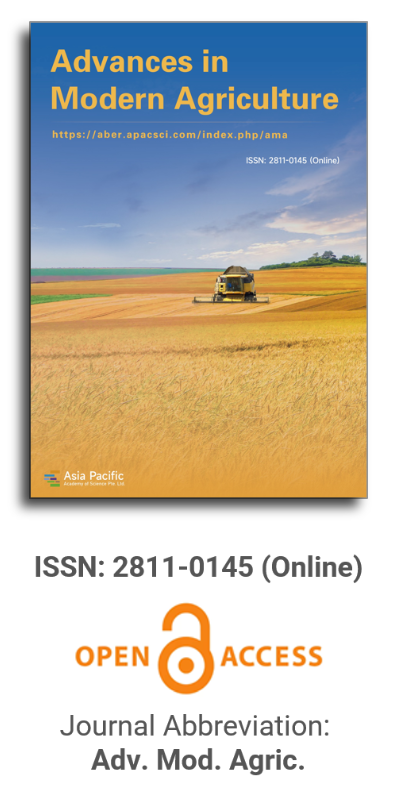


Research on a prolonged release system of urea powder potentially applied in sustainable agriculture
Vol 3, Issue 2, 2022
VIEWS - 4157 (Abstract)
Download PDF
Abstract
A prolonged release system (SLIP) of urea powder encapsulated in a wheat gluten matrix was investigated as a sustainable substitute for use in agriculture with the goal of lowering nitrogen losses in the soil. Thermogravimetry (TGA), Fourier Transform Infrared Spectroscopy (FT-IR), and Scanning Electron Microscopy (SEM) were the methods used to characterize SLIP. The urea release kinetics in water were then assessed. Very porous structures were produced, the thermal stability of SLIP was noted, and interactions between urea and gluten proteins through hydrogen bonds were verified. According to the kinetics, urea was released at a high rate (38%) in the first ten minutes and reached the diffusion equilibrium (86.35%) after 36 hours. There is a chance that urea SLIP will be employed as a sustainable substitute in agriculture.
Keywords
References
- Fageria NK, Baligar VC. Enhancing nitrogen use efficiency in crop plants. Advances in Agronomy 2005; 88: 97–185. doi: 10.1016/S0065-2113(05)88004-6
- Ortiz A, Venialgo M. The use of chemical fertilizers and the growth of Paraguayan agriculture (Spanish). Accounting, Marketing and Business 2017; 3(1).
- Guha T, Gopal G, Kundu R, et al. Nanocomposites for delivering agrochemicals: A comprehensive review. Journal of Agricultural and Food Chemistry 2020; 68(12): 3691–3702.
- Tasca AL, Nessi S, Rigamonti L. Environmental sustainability of agri-food supply chains: An LCA comparison between two alternative forms of production and distribution of endive in northern Italy. Journal of Cleaner Production 2017; 140: 725–741. doi: 10.1016/j.jclepro.2016.06.170
- Wu Y, Li Y, Fu X, et al. Effect of controlled-release fertilizer on N2O emissions and tea yield from a tea field in subtropical central China. Environmental Science and Pollution Research 2018; 25: 25580–25590. doi: 10.1007/s11356-018-2646-2
- Mukerabigwi JF, Wang Q, Ma X, et al. Urea fertilizer coated with biodegradable polymers and diatomite for slow release and water retention. Journal of Coatings Technology and Research 2015; 12: 1085–1094. doi: 10.1007/s11998-015-9703-2
- Azeem B, KuShaari KZ, Man ZB, et al. Review on materials & methods to produce controlled release coated urea fertilizer. Journal of Controlled Release 2014; 181: 11–21. doi: 10.1016/j.jconrel.2014.02.020
- Yamamoto CF, Pereira EI, Mattoso LHC, et al. Slow release fertilizers based on urea/urea–formaldehyde polymer nanocomposites. Chemical Engineering Journal 2016; 287: 390–397. doi: 10.1016/j.cej.2015.11.023
- Gamboa OD, Gonçalves LG, Grosso CF. Microencapsulation of tocopherols in lipid matrix by spray chilling method. Procedia Food Science 2011; 1: 1732–1739. doi: 10.1016/j.profoo.2011.09.255
- Dima Ş, Dima C, Iordăchescu G. Encapsulation of functional lipophilic food and drug biocomponents. Food Engineering Reviews 2015; 7(4): 417–438. doi: 10.1007/s12393-015-9115-1
- Blomfeldt TOJ, Kuktaite R, Johansson E, et al. Mechanical properties and network structure of wheat gluten foams. Biomacromolecules 2011; 12(5): 1707–1715. doi: 10.1021/bm200067f
- Scherf KA, Koehler P, Wieser H. Gluten and wheat sensitivities—An overview. Journal of Cereal Science 2016; 67: 2–11. doi: 10.1016/j.jcs.2015.07.008
- Castro-Enríquez DD, Rodríguez-Félix F, Ramírez-Wong B, et al. Preparation, characterization and release of urea from wheat gluten electrospun membranes. Materials 2012; 5(12): 2903–2916. doi: 10.3390/ma5122903
- Barreras-Urbina CG, Rodríguez-Félix F, López-Ahumada GA, et al. Microparticles from wheat-gluten proteins soluble in ethanol by nanoprecipitation: preparation, characterization, and their study as a prolonged-release fertilizer. International Journal of Polymer Science 2018; 2018: 1042798. doi: 10.1155/2018/1042798
- Fessi H, Puisieux F, Devissaguet J P, et al. Nanocapsule formation by interfacial polymer deposition following solvent displacement. International Journal of Pharmaceutic 1989; 55(1): R1–R4. doi: 10.1016/0378-5173(89)90281-0
- Gulfam M, Kim J, Lee JM, et al. Anticancer drug-loaded gliadin nanoparticles induce apoptosis in breast cancer cells. Langmuir 2012; 28(21): 8216–8223. doi: 10.1021/la300691n
- Patton CJ, Crouch SR. Spectrophotometric and kinetics investigation of the Berthelot reaction for the determination of ammonia. Analytical Chemistry 1977; 49(3): 464–469. doi: 10.1021/ac50011a034
- Rodríguez-Félix DE, Pérez-Martínez CJ, Castillo-Ortega MM, et al. pH- and temperature-sensitive semi-interpenetrating network hydrogels composed of poly(acrylamide) and poly(γ-glutamic acid) as amoxicillin controlled-release system. Polymer Bulletin 2011; 68(1): 197–207. doi: 10.1007/s00289-011-0549-1
- Dórame-Miranda RF, Rodríguez-Félix DE, López-Ahumada GA, et al. Effect of pH and temperature on the release kinetics of urea from wheat-gluten membranes obtained by electrospinning. Polymer Bulletin 2018; 75(11): 5305–5319. doi: 10.1007/s00289-018-2327-9
- Robles-García MA, Francisco RF, Márquez-Ríos E, et al. Biomedical, textile and food applications of nanostructures made by electrospinning (Spanish). Biotecnia 2014; 16(2): 44–52. doi: 10.18633/bt.v16i2.46
- Shi X, Li C, Gao S, et al. Combination of doxorubicin-based chemotherapy and polyethylenimine/p53 gene therapy for the treatment of lung cancer using porous PLGA microparticles. Colloids and Surfaces B: Biointerfaces 2014; 122: 498–504. doi: 10.1016/j.colsurfb.2014.07.020
- Hao S, Wang B, Wang Y. Porous hydrophilic core/hydrophobic shell nanoparticles for particle size and drug release control. Materials Science and Engineering: C 2015; 49: 51–57. doi: 10.1016/j.msec.2014.12.029
- Bruinink A, Wang J, Wick P. Effect of particle agglomeration in nanotoxicology. Archives of Toxicology 2015; 89(5): 659–675. doi: 10.1007/s00204-015-1460-6
- Davidov-Pardo G, Joye IJ, McClements DJ. Encapsulation of resveratrol in biopolymer particles produced using liquid antisolvent precipitation. Part 1: Preparation and characterization. Food Hydrocolloids 2015; 45: 309–316. doi: 10.1016/j.foodhyd.2014.11.023
- Irissin-Mangata J, Bauduin G, Boutevin B, Gontard N. New plasticizers for wheat gluten films. European Polymer Journal 2001; 37(8): 1533–1541. doi: 10.1016/S0014-3057(01)00039-8
- Tapia‐Hernández JA, Rodríguez‐Félix DE, Plascencia‐Jatomea M, et al. Porous wheat gluten microparticles obtained by electrospray: Preparation and characterization. Advances in Polymer Technology 2017; 37(6): 2314–2324. doi: 10.1002/adv.21907
- Mathrmool K, Akkarapongtrakul A, Sukkum S, et al. Low temperature fabrication of lead-free KNN-BNT ceramics via the combustion technique. Ferroelectrics 2014; 458(1): 136–145. doi: 10.1080/00150193.2013.850351
- Li W, Dobraszczyk BJ, Dias A, et al. Polymer conformation structure of wheat proteins and gluten subfractions revealed by ATR‐FTIR. Cereal Chemistry 2006; 83(4): 407–410. doi: 10.1094/cc-83-0407
- Mulder VL, de Bruin S, Schaepman ME, et al. The use of remote sensing in soil and terrain mapping—A review. Geoderma 2011; 162(1–2): 1–19. doi: 10.1016/j.geoderma.2010.12.018
- Bird RB, Bird DW, Smith EA, Kushnick GC. Risk and reciprocity in Meriam food sharing. Evolution and Human Behavior 2002; 23(4): 297–321. doi: 10.1016/S1090-5138(02)00098-3
- Trenkel ME. Controlled-Release and Stabilized Fertilizers in Agriculture. International Fertilizer Industry Association; 2010.
Supporting Agencies
Copyright (c) 2022 Anayza Echevarría Hernández, Francisco Javier Wong-Corral, Jesús Borboa-Flores, Francisco Rodríguez-Félix, Carmen Lizette Del Toro-Sánchez, José Luís García-Hernández
License URL: https://creativecommons.org/licenses/by/4.0/

This site is licensed under a Creative Commons Attribution 4.0 International License (CC BY 4.0).

Prof. Zhengjun Qiu
Zhejiang University, China

Cheng Sun
Academician of World Academy of Productivity Science; Executive Chairman, World Confederation of Productivity Science China Chapter, China
Indexing & Archiving
In the realm of modern agriculture, the integration of cutting-edge technologies is revolutionizing the way we approach sustainable farming practices. A recent study published in Advances in Modern Agriculture titled "Classification of cotton water stress using convolutional neural networks and UAV-based RGB imagery" has garnered significant attention for its innovative approach to precision irrigation management. Conducted by researchers from Institute of Data Science and the AgriLife Research and Extension Center of Texas A&M University (authors's information is below). This study introduces a novel method for classifying cotton water stress using unmanned aerial vehicles (UAVs) and convolutional neural networks (CNNs), offering a powerful solution for optimizing water use in agriculture.
Modern agricultural technology is evolving rapidly, with scientists collaborating with leading agricultural enterprises to develop intelligent management practices. These practices utilize advanced systems that provide tailored fertilization and treatment options for large-scale land management.
This journal values human initiative and intelligence, and the employment of AI technologies to write papers that replace the human mind is expressly prohibited. When there is a suspicious submission that uses AI tools to quickly piece together and generate research results, the editorial board of the journal will reject the article, and all journals under the publisher's umbrella will prohibit all authors from submitting their articles.
Readers and authors are asked to exercise caution and strictly adhere to the journal's policy regarding the usage of Artificial Intelligence Generated Content (AIGC) tools.
Asia Pacific Academy of Science Pte. Ltd. (APACSCI) specializes in international journal publishing. APACSCI adopts the open access publishing model and provides an important communication bridge for academic groups whose interest fields include engineering, technology, medicine, computer, mathematics, agriculture and forestry, and environment.



.jpg)
.jpg)

.jpg)
